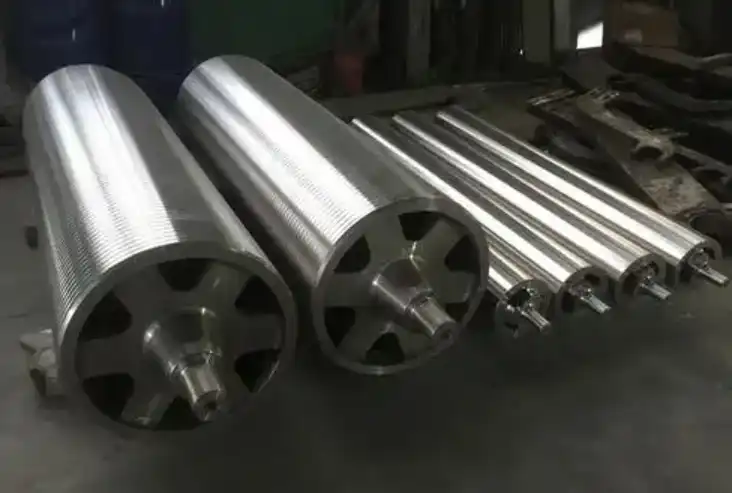Causes of Poor Stabilizer Roll Performance
Wear and Tear
Over time, stabilizer rolls can experience significant wear and tear due to continuous operation. This gradual degradation can manifest in several ways, including surface roughness, uneven wear patterns, and loss of proper dimensions. As the roll's surface deteriorates, it becomes less effective at maintaining proper tension and alignment, leading to inconsistencies in the production process. The wear process may be accelerated by factors such as high-speed operations, abrasive materials, or inadequate lubrication, further compromising the roll's performance and lifespan.

Improper Maintenance
Neglecting regular maintenance routines can severely impact stabilizer roll performance. Failure to clean, inspect, and adjust rolls according to manufacturer specifications can result in buildup of debris, misalignment, and imbalance issues. These problems can escalate quickly, leading to more significant performance degradation and potential equipment failure. Proper maintenance practices, including regular cleaning, lubrication, and alignment checks, are essential for preserving optimal stabilizer roll function and extending its operational life.
Material Incompatibility
Using stabilizer rolls that are not suitable for the specific materials being processed can lead to poor performance. Different production processes and materials require rolls with specific surface properties, hardness, and chemical resistance. When there is a mismatch between the roll characteristics and the material being handled, issues such as sticking, slipping, or chemical degradation of the roll surface can occur. This incompatibility not only affects the quality of the product but can also accelerate wear on the stabilizer rolls themselves, leading to more frequent replacements and increased production costs.
Consequences of Suboptimal Stabilizer Roll Function
Product Quality Issues
One of the most immediate and noticeable impacts of poor stabilizer roll performance is a decline in product quality. When stabilizer rolls fail to maintain proper tension and alignment, it can result in various defects in the final product. These defects may include wrinkles, creases, thickness variations, or surface imperfections. In paper production, for example, inconsistent stabilizer roll performance can lead to uneven paper thickness or poor surface finish, rendering the product unsuitable for high-quality printing applications. Similarly, in film manufacturing, poor roll performance can cause optical defects or inconsistent material properties, potentially affecting the film's functional characteristics.
Increased Waste and Inefficiency
Suboptimal stabilizer roll function often leads to increased waste and reduced production efficiency. As product quality declines due to poor roll performance, a higher percentage of output may fail to meet quality standards, resulting in more rejected material. This increase in waste not only represents a direct loss of raw materials but also contributes to higher production costs and reduced overall efficiency. Additionally, the need for more frequent adjustments, rework, or machine stoppages to address quality issues further diminishes productivity, impacting production schedules and potentially leading to delays in order fulfillment.
Equipment Damage and Downtime
Poor stabilizer roll performance can have cascading effects on other components of the production line. Excessive vibration or misalignment caused by faulty rolls can lead to accelerated wear on bearings, drive systems, and other machine parts. This increased wear not only shortens the lifespan of these components but also raises the risk of unexpected equipment failures. Such failures can result in unplanned downtime, disrupting production schedules and incurring significant repair costs. Moreover, the unpredictable nature of these breakdowns can complicate maintenance planning and inventory management, potentially leading to longer periods of inactivity while waiting for replacement parts or specialized repair services.
Strategies for Improving Stabilizer Roll Performance
Regular Inspection and Maintenance
Implementing a robust inspection and maintenance program is crucial for ensuring optimal stabilizer roll performance. This should include regular visual inspections to identify signs of wear, damage, or misalignment. Utilizing advanced monitoring technologies, such as vibration analysis or thermal imaging, can help detect potential issues before they escalate into major problems. Scheduled maintenance activities should encompass cleaning, lubricating, and adjusting rolls according to manufacturer specifications. By proactively addressing minor issues and maintaining proper roll condition, companies can significantly reduce the risk of performance degradation and unexpected failures.
Proper Roll Selection and Material Compatibility
Choosing the right stabilizer roll for specific production requirements is essential for maintaining optimal performance. This selection process should consider factors such as the material being processed, production speed, environmental conditions, and desired surface properties. Consulting with roll manufacturers or industry experts can help ensure that the selected rolls are compatible with the production process and capable of delivering the required performance characteristics. Additionally, periodically reassessing roll selection as production needs evolve can help maintain efficiency and product quality over time.
Advanced Roll Technologies and Coatings
Investing in advanced stabilizer roll technologies and coatings can significantly enhance performance and longevity. Modern roll designs may incorporate features such as dynamic balancing, temperature control, or specialized surface patterns to improve tension control and material handling. High-performance coatings can provide increased wear resistance, improved release properties, or enhanced chemical resistance, depending on the specific application requirements. While these advanced technologies may represent a higher initial investment, they can offer substantial long-term benefits in terms of improved product quality, reduced downtime, and lower overall operational costs.
In conclusion, the impacts of poor stabilizer roll performance on production can be far-reaching and costly. By understanding these impacts and implementing effective strategies for maintenance, selection, and technological advancement, manufacturers can significantly improve their production processes, product quality, and overall operational efficiency. For more information on high-quality stabilizer rolls and expert advice on optimizing your production line, please contact us at info@welongpost.com.



